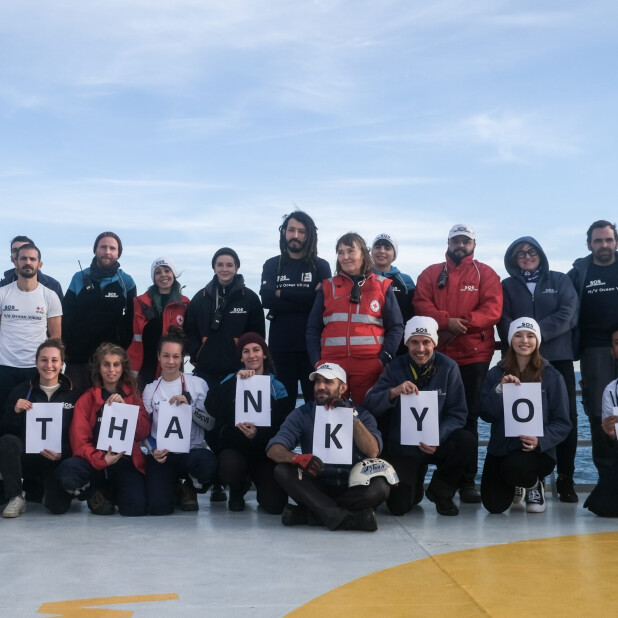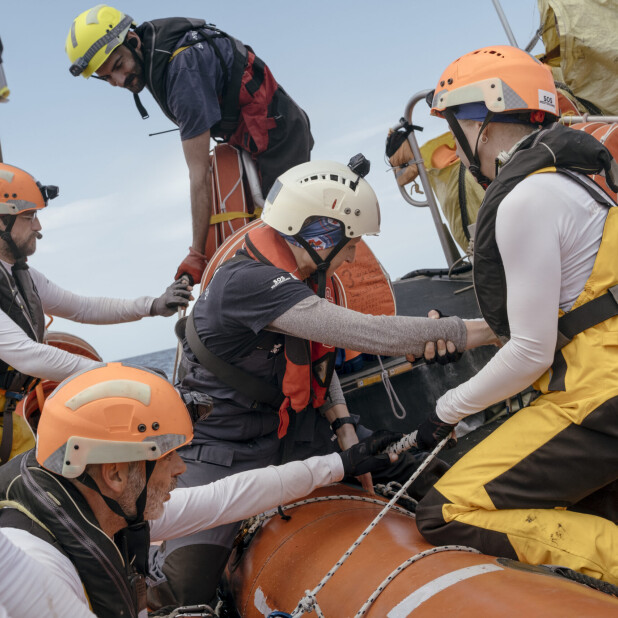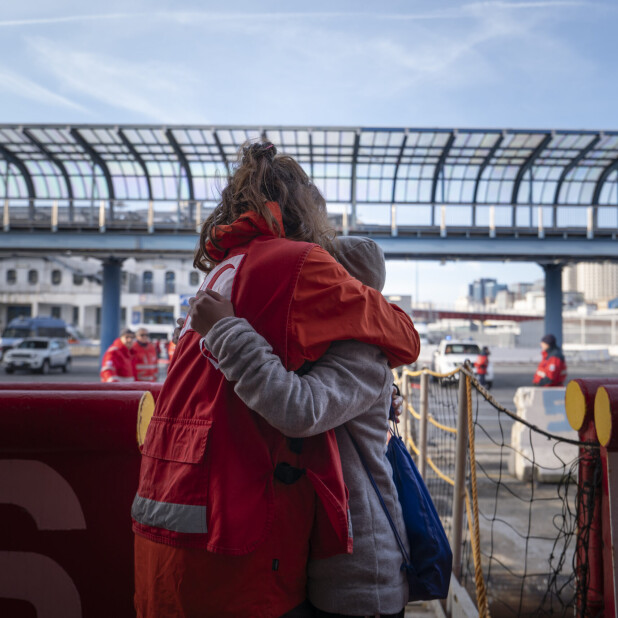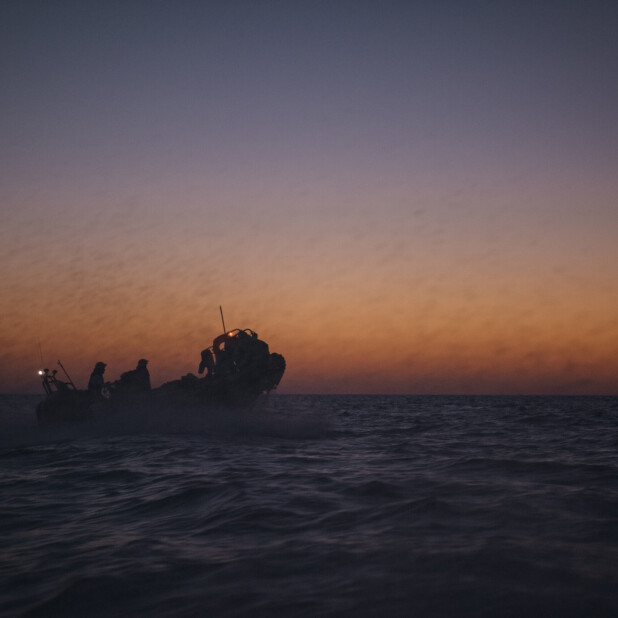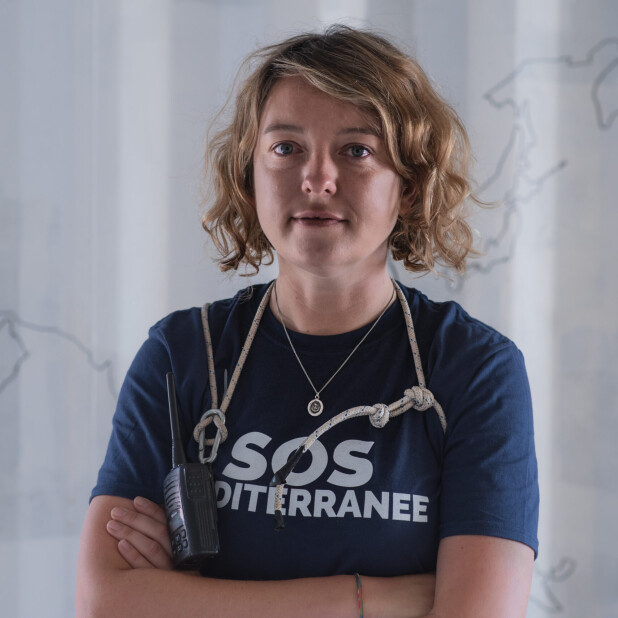
Giannis is a member of the search and rescue team onboard the Ocean Viking, coming from Greece. He embarked on his first mission with SOS MEDITERRANEE in April 2021. Following the tragic events witnessed at sea by our teams on April 22nd, Giannis was approached by EFSYN, a Greek newspaper, to tell the story from the point of view of a rescuer and European citizen working aboard a civil search and rescue vessel in the Central Mediterranean. Giannis’ text is available in English here:

Do you remember that special feeling when you were little, hanging out on the couch and watching a movie like „The Perfect Storm“? That moment when you get goosebumps, or a churning in your stomach, or when you feel that weightlessness inside you when plunging down on a roller-coaster in an amusement park.
It was April 20th just before midnight when we were informed of a wooden boat in distress with 42 people onboard, 140 Nautical Miles West from our location, over 10 hours away. During the travel, we were informed that the boat was on the move again and we were given a new location. Shortly before 10 am (April 21) we were informed of two more rubber boats in distress with around 120 people onboard each, to the East. The complete opposite from our direction at that time. After reaching the latest location of the wooden boat, we started a 7–hour search with no positive results. It was most likely that they had managed to sail up North and reach the Maltese SAR zone, or even closer, to Tunisia. They could have also been intercepted by a Libyan Coast Guard vessel, or worse, get lost at sea…
At 6 pm we decided to abandon the search and to head East, towards the 2 other rubber boats in distress, knowing that the weather conditions were becoming dangerous from the evening onwards. We had also been informed that one of the two rubber boats had been intercepted by a Libyan Coast Guard vessel, but not the second one. We were 10 hours away, about 100 Nautical Miles distance: in other words, with only one SAR vessel operating in this area, chances were already very slight to find this boat.
When the sun set, the ship was sailing at full speed, still fighting against the weather, which seemed to be getting worse. Our first thoughts were what we were going to find ahead. New information came from the Bridge: an unknown asset (we later learned it was a Frontex aircraft) spotted the boat and sent out a Mayday shortly after 7 pm and another almost an hour later. Three merchant ships in the area responded and began Heading towards the location. Before 10 pm, we were informed by Alarm Phone that they had lost contact with the boat due to low battery on the satellite phone of the people in distress.
The weather conditions were deteriorating, the wind getting stronger, reaching 40 knots and the waves over 4 meters. It was impossible to sleep. Some of us spent the night in the toilet. The plunges the ship did were like free-falling. It was impossible to stay lying down under these conditions. My stomach was feeling like it came out of a blender. So I decided to get up. Then I met the Search and Rescue (SAR) Team Leader, who was also quite anxious, despite his long experience. We were now beginning to accept that the chances of these people surviving were close to zero. We still tried to consider finding them, making plans on how we would attempt doing a rescue given the circumstances, while the back deck of the ship was flooded with waves crashing through the sides. At some point we realized that we might not be able to launch any of our three rescue boats, as the risk of an accident and loss of a crew member was too high.
We had no other hope than the support of the merchant ships. One was a tanker and could help us by taking a position on the windward side. This would be our only chance to launch the rescue boats safely and reasonably, and attempting the rescue deploying all our equipment, whether survivors could be found inside the boat or in the water. All sorts of questions and scenarios kept rushing through our minds, the most important being how far away the tanker would be when the boat would be located and of Course what condition it would be in. Time was passing, the merchant ships were already performing a search and rescue pattern, without any sort of coordination from any rescue coordination centres (MRCC). These people’s destiny was left at the mercy of every state’s good will, with three merchant ships (bless the captains for doing their duty) and one NGO rescue ship fighting for the impossible.
It was a shortly after 5 am (April 22 now) when we arrived in the area and in coordination with the merchant ships, we designated an area to search. It was dawn and we were all prepared for any eventuality at any moment. The ship was completely quiet, it felt like a graveyard. All hopes of a miracle had vanished. However, we did prepare the ship’s deck for a possible approach alongside, since the rescue boats could definitely not be launched anymore. It was a desperate move, a clear “don’t” in other circumstances, but we were past the point of playing „by the book“. By now, the general mood was “we may cause chaos, but we will do our best to save as many lives as possible”. Bags full of life jackets and ropes were placed in every corner of the deck and especially around the „rescue zone“. We were ready for anything.
Requests for aerial support from our Bridge to the Italian Rescue Coordination Centre (ITMRCC) and Frontex had been repeated since morning. It was around 12:30 pm when one of the merchant ships spotted 3 bodies. A few minutes later, a Frontex plane spotted the remains of the boat. It was obvious now that our worst-case scenario was the reality. As we approached the location, we could see the dismantled rubber boat, and while getting closer, numerous bodies floating in the water. No one had survived. Around 130 people perished in their attempt to escape uncertainty and modern slavery, for a better life. They died in an unimaginable way, drowning, alone. On a night where it seemed Poseidon was exploding all his rage at how unfair and disgusting humanity is.
I believe that from the nightmarish depths of Libya to the aristocratic salons of Brussels or any other European capital, this story and the loss of these 130 souls will not generate any change. I would like to, but we keep witnessing such incidents, regardless of Human Rights and the institutions that ‚protect‘ them, Maritime Laws and the conventions that ‚protect‘ them. So, a question needs to prevail: “What if it were a cruise ship in distress?”
P.S. 1) Later on we were happy to hear from Alarm Phone that the first boat of about 42 people that we were searching for reportedly reached Tunisia.
P.S. 2) For „historical“ reasons, I think it is important to give the names of the ships that did their duty, which is rare due to the pressure from the companies and the deterrent effect of merchant vessels being kept in prolonged standoffs without assistance from authorities. M/V MY ROSE, M/V ALK and M/T VS LISBETH. Unfortunately, we do not have the names of the captains.
***
Photos: Flavio Gasperini / SOS MEDITERRANEE

